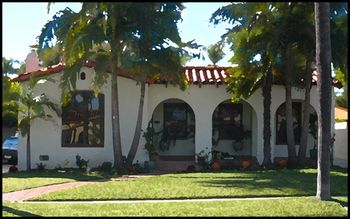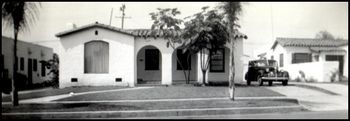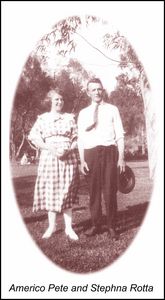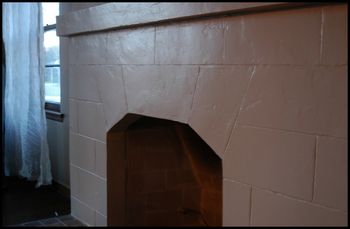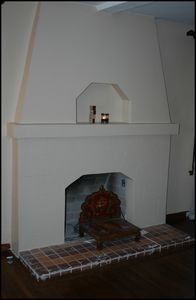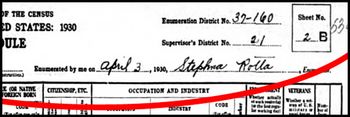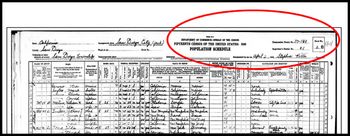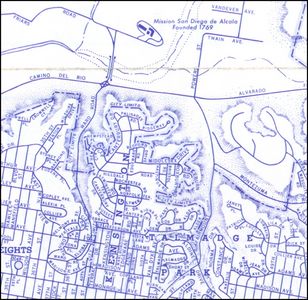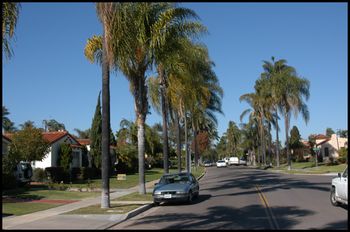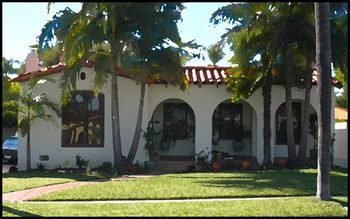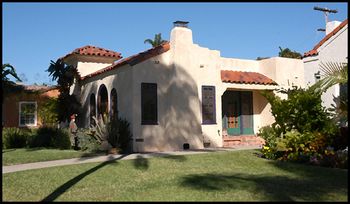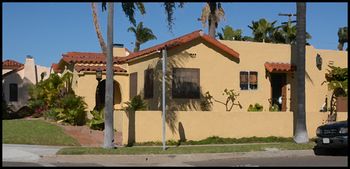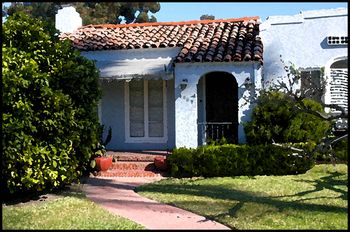|
|
 |
|
|
Historical Landmark No. 736 Kensington Community Historical Landmark No. 736 - Designated November 2005 |
|
|
New Kensington Landmark Americo Pete and Stephna Rotta House is a one-story 1930 Spanish Eclectic house located in the community of Kensington Manor Unit 1. The house is significant for its architecture, which exhibits a colonnade of three mission style arches along the front façade and a distinctive flat topped cathedral front window. This distinctive shape is echoed as a theme throughout the house in the fireplace niche, room entries, and doorways. The house is in a style that met the strict architectural review standards for good design and construction that were mandatory for residences in the expensive estate community. | |
|
|
Americo Pete “AP” Rotta and his wife Stephna built this house in 1930 at the beginning of the Great Depression. This is the first house designed and built by AP Rotta that has come before the Historical Resources Board for review and been landmarked. Americo Pete Rotta was born in Kansas on November 13, 1894 to Italian immigrant parents and died in San Diego on April 5, 1979 (Virginia Rotta 2004). Having come from Bergamo, Italy, a town located east of Milan at the foot of the Alps, his parents named their first born son Americo in honor of their new homeland. Much of the biographical information for this study came from interviews with Virginia Rotta and Don Rotta in 2004. | ||
|
|
He and his brother, Joe Rotta, married sisters in 1926. A veteran of World War I, AP served in the United States Army Corps of Engineers and built bridges and roads across Europe. Stephna C. Rotta was born in New York on June 16, 1897 and died in San Diego on January 26, 1985 Her mother’s maiden name was Stortz. After mustering out of the Armed Forces, AP found work as a cook at the Broadmoor Hotel in Colorado Springs. It was there he and Stephna married in 1926. | ||
|
|
Oral testimony from Dan Rotta, their son, reveals that the couple worked as a team, with Stephna going to the library to research empty lots listed for sale in the newspapers and the couple then deciding which lots to buy. AP, or “Mack” as he was more typically known, would then build the house. While it is believed that Americo Pete was the carpenter and contractor for the houses, Stephna clearly had a major role as a business partner and by combining their various skills they built the house at 4958 Marlborough. When they moved to San Diego, he accepted a position as a purchasing agent in food services at the Hotel Del Coronado and in 1926 they moved to 4164 El Cajon Boulevard. He moonlighted in real estate and opened an office at 3820 El Cajon Boulevard, from which Stephna worked. They remained in those jobs and locations until 1928, when they built their home at 5036 Marlborough in Kensington. | ||
|
|
Interviews with the Rotta’s son and nephew indicate that he had carpentry skills and was a jack of all trades, but they knew little beyond that. Research into fellow builder Louise Mary Severin, who built numerous homes in the same area at that time suggests a relationship between the two couples and may help explain how they got into the real estate construction business. | ||
|
|
First, the 1930 Directory shows that Louise and Hilmer Severin lived at 4970 Marlborough Drive, the house immediately next door to the north of the Robb/Rotta House. Second, documentary evidence in the form of a Deed found in the Recorder’s Office shows that in March, 1929, the Rottas sold another Kensington lot in their block to Louise Severin, confirming that there was a financial relationship between the two families. Third, and perhaps only coincidentally, Louise Henkensmeier married Hilmer Severin, and her sister married Hilmer’s brother, in other words, the two Henkensmeier sisters married the two Severin brothers. This was also the case with AP and Stephna, as AP Rotta’s brother Joe married Stephna’s sister. It is possible that this family relationship formed common ground between the Rottas and the Severins. At present, there is not sufficient information about the Rotta’s and their involvement in the building industry to speculate much further. | |
|
|
Less is known of Stephna’s career, but San Diego City Directory listings and family oral history about their work experience suggests that while AP worked for the Hotel del Coronado, Stephna operated their real estate office at 3820 El Cajon Boulevard. Stephna worked right along with AP, and both listed themselves as building contractors independently in the directories. Another insight into her activities can be seen on the 1930 U.S. Census, where her name appears as an enumerator, or recorder of the data. | ||
|
|
It is not known how she got this important job, but the census sheets, recorded her own handwriting, remain today as testimony to her door to door trek as one of San Diego’s dedicated group of census takers. Based on this, it is probable she was involved in other community activities in her career that did not surface in this research project and are now invisible to her descendants. | |
|
|
They did well in the construction business and eventually moved to Escondido where they continued to build in the Park Hill area and at Green Ranch by Lake Hodges. There, they built seven homes on a 22-acre ranch in Escondido, at least three houses at Park Hill in Escondido, as well as homes on Sunset in Escondido in 1935 or 1936. Later, they bought lots and built houses on Chestnut Street in Escondido until World War II terminated custom house building in 1942. After World War II they continued to build Spanish Eclectic style houses in North County at least into the 1950s. | ||
|
|
The Rotta’s role in the Kensington community and San Diego in general brings new information to our greater understanding of the activities of the resident builders who created Kensington’s distinct character. It also raises interesting questions about economic survival, in light of the devastating impact of the stock market crash at the end of 1929 and subsequent Great Depression. Other builders, such as Master Builder Louise Severin and her husband Hilmer, built many Kensington / Talmadge Park homes in the 1930s, and their role is becoming better understood as more area houses are studied. The Rotta’s role, however, has only recently emerged and it provides a new opportunity to learn more about the builders of Kensington. This relationship between the developers, designers, financiers, and builders is interesting and relevant in the Kensington community because of the strict and mandatory restrictions that were imposed by the subdivision’s creators. Their stated aim was to protect the investment value of the properties and ensure the long-term exclusive character of the community in a time when land transactions were still paid for in gold coin. And it worked. | ||
|
|
Today, owners of Kensington homes still pride themselves on the exclusive character of their community for the very same reasons envisioned by the subdivision’s creators. However, the stories of the early Kensington builders and residents of these homes have by and large faded into obscurity. Homeowners and researchers interested in the area now want to know more about the people who came into the community. | ||
|
|
- - - - - - - K E N S I N G T O N - - - G A L L E R Y - - - - - - - | |
|
|
| ||
|
|
| ||
|
|
| ||
|
|
| ||
|
|
Home | Designations | Qualifications | Company Profile | Newsletter | Links Archaeology
& Historic Preservation www.legacy106.com |
|

